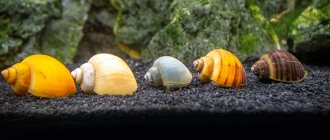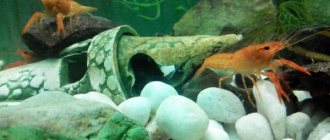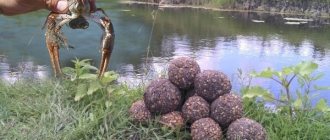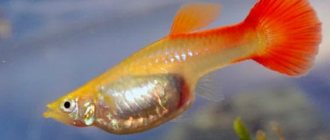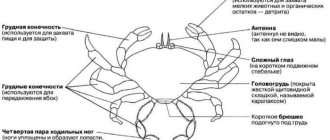Quickly navigate to the article
- 1 Description of fish
- 2 Types of crucian carp
- 3 Silver fish
- 4 Golden crucian carp
- 5 Other types
- 6 How to equip a fish home
- 7 Required equipment
- 8 Decorations
- 9 Landscaping
- 10 Crucian carp in the aquarium: care and care
- 11 What to feed
- 12 Breeding in captivity
- 13 Pet's neighbors 13.1 Other interesting articles
Crucian carp, perch, roach and ruffe are fish designed to exist in natural bodies of water. However, for some time now people have begun to domesticate many species of finned fish. Various breeds of fish are bred in artificial lakes and ponds. Some are domesticated so much that they become full family members along with dogs or cats. Such fish, in particular, are crucian carp in the aquarium.
Description of fish
Oddly enough, crucian carp are the direct ancestors of the goldfish, the heroine of most fairy tales and legends. But river fish of the carp family are much larger than their direct descendants. The body shape of domestic crucian carp in the aquarium comes in two types. The fish has either an oblong or slightly rounded body, slightly flattened on the sides. Smooth large scales are reliable armor for crucian carp.
The color of the fish depends on the variety and can vary from silver to golden color. A high fin adorns the thick back of the fish. The weight of crucian carp can reach more than five kilograms, and the length can be more than 50-60 centimeters.
The fish's head is small with small eyes and mouth. The fish's teeth are arranged in one row and are small and sharp. Spiny barbs in the dorsal and anal fin are a distinctive feature that allows you to recognize crucian carp among other fish.
How long does crucian carp live in an aquarium? More than twelve years. Depending on the type of fish, the lifespan can range from 8 to 14 years.
Lifespan
Adults under optimal living conditions grow to an average of 15 centimeters. There are also specimens whose body length is more than 25 cm.
These are long-lived. Their average lifespan is about 14 years. There is a long-liver among aquarium crucians who lived for 43 years. This is an English goldfish called Tish.
Every interested aquarist can buy himself a beautiful golden pet. It does not require special conditions of detention and is unpretentious in terms of food supply and care conditions. In return, it will delight its owner with its beauty and activity for many years.
Silver fish
The body color of this extraordinary fish is light gray with a metallic tint. The back is a little darker. The shape of the silver crucian carp is more oblong than that of its golden relative. Since young fish are in no way inferior in size to adult fish, their distinctive feature is their scales. In adult waterfowl, the cover is thicker and rougher. To keep crucian carp in an aquarium, it is recommended to purchase small fish.
The fish is the most undemanding to care for. Even for spawning, it requires a water temperature of no higher than 14 degrees. These are very cold-loving creatures. For wintering, the temperature of the water in the container should not exceed 8 degrees. In such an environment, pets hibernate and do not eat.
Compatibility with other fish
The goldfish is large in size, it can reach a length of 20 cm, so as neighbors for it you need to select species that cannot become lunch for it. Carassius auratus is slow and not aggressive; it rarely attacks other aquarium inhabitants, but due to its gluttony it can eat smaller, slower fish, such as lalius, for example. Nimble neighbors, on the contrary, can take food away from her.
It is not recommended to keep goldfish together with barbs and other aggressive species, since the latter will pluck the tails of their slow-moving neighbors and thereby spoil their appearance. It is best to keep goldfish separately from other aquarium inhabitants. For those who are fond of fish, the goldfish variety can bring a lot of pleasure, but only with the right approach to its maintenance.
Golden crucian carp
Another name is ordinary. The natural habitat of golden crucian carp is rivers and reservoirs with weak currents. In an aquarium, the fish can grow up to 20 centimeters, although in natural conditions there are individuals 45-47 centimeters long.
The color of the scales of golden crucian carp has a reddish-brown tint. The body is more rounded than that of its relative, the silver fish. The pet is quite unpretentious in care. The golden crucian carp overwinters at the bottom of the container, burrowing into the silt. Polluted water is not a problem for him, since he can easily survive in an environment poor in oxygen.
You can breed golden crucian carp starting from the age of three or four years.
Feeding regimen depending on the season
In spring, feeding begins in late April - early May. They finish feeding the fish in the second half of September, as weather conditions worsen.
With the onset of frost and ice formation on the surface of the garden pond, it is necessary to provide air supply for the fish. Otherwise, the pond inhabitant will not survive the winter and will die from lack of oxygen. For this purpose, special aerators are used that provide air circulation. They are installed at several points throughout the entire reservoir area.
Other types
In addition to traditional varieties, there is also the heroine of folk tales - the goldfish. She is a direct descendant of the silver crucian carp. All representatives of this species (and there are about three hundred of them) are intended for living at home. All goldfish differ in size, which range from 2 to 45 centimeters. The next distinguishing feature between the varieties of domesticated crucian carp is the color of the scales, which can be almost all colors of the rainbow. The length of the body, fins and tail will also help distinguish one subspecies of pet from another. Notable are the eyes of the fish, which vary from small to large and bulging.
In addition to goldfish, the so-called Japanese crucian carp lives in the waters of Japan and Taiwan. The size of the fish ranges from 35 to 40 centimeters. It is practically impossible to domesticate and exists only in the wild.
Nitrogen cycle
After filling with water and installing the equipment, processes called “aquarium maturation” begin to occur in the water. More details in the section “Nitrogen cycle”. This lasts about a week, during which time fish cannot be released. It is because of this process that it is better to prepare the aquarium in advance, before catching the crucian carp.
Necessary equipment
Perhaps the most basic item in a home fish container is the filtration system. Although crucian carp are not afraid of muddy water, it is still advisable to install an external filter on the aquarium, which, in tandem with the internal one, will ideally perform its main function. An external installation makes it possible to keep a large number of fish in tanks. The internal unit removes the turbidity raised by the fish from the bottom of their home. The best option for caring for crucian carp in an aquarium is to install a phytofilter.
Another important device in a fish’s home is the compressor. The functions of this device are as follows:
- The compressor is designed to provide aeration for the aquarium. Air bubbles formed as a result of the operation of the device saturate the vessel with additional oxygen.
- Thanks to the compressor, the water in the container is mixed. This significantly improves the quality of the aquarium contents. If the container is equipped with a thermoregulation system - a thermostat, then the heated layers of water due to the operation of the compressor are mixed with cooled ones. This way the optimal temperature is maintained.
- This installation gives the aquarium an aesthetic appearance.
- The compressor prevents the formation of a film on the surface of the water. As a result, the appearance of harmful bacteria and dust is prevented.
- Crucian carp are fish accustomed to living in natural bodies of water with moderate currents. Standing water in an aquarium causes some discomfort for pets. A compressor eliminates this problem. As a result of its functioning, water moves, simulating the flow of a river. Fish will swim in such a vessel with great pleasure.
How to properly arrange a pond
The efficiency of any business begins with an analysis of expenses and income. And if you correctly take into account all the nuances, you can count on the result. Experienced fish farmers believe that a reservoir should be used not only to support a school of crucian carp, but also so that young animals or several species of fish can be raised in it.
Features of constructing a pond for growing crucian carp:
- Small tanks require serious maintenance, and maintaining a large one will be very expensive, so the optimal sizes are in the range of 30–50 m².
- One of the sections of the reservoir should remain in the shade.
- The pond should not be flooded by flood waters in the spring, and for this purpose it is placed on a hill.
- Be sure to create a complex bottom topography. For wintering you will need at least one deep-sea hole and a shallow where the fish will feed.
- Different fish need different soil. For example, crucian carp need silt, because in nature in winter they burrow into a silty cushion at the bottom.
Pay attention to the description, characteristics and catching of silver crucian carp.
Requirements for the location and its parameters
Water is the most important thing for fish farming. Without it, a mini-farm is impossible. That is why, before deciding to start breeding crucian carp in a private country pond, you need to create an artificial reservoir suitable for this.
Before creating a pond in your country house, decide on its location. It should be chosen so that in summer:
- from dawn to 10 am - it was illuminated by the sun;
- from 11 to 15 o'clock it could hide in partial shade.
Important! To successfully raise fish in a pond, it must be exposed to the sun for at least 5 hours a day.
Warm water negatively affects the well-being of fish. It also promotes the development of algae and leads to a lack of oxygen, so it is best to place the future tank closer to the shade of trees. It is advisable that the shadow falls in the afternoon, when it is hottest. There is no need to specially plant trees, otherwise during growth their root system will damage the reservoir, and falling leaves will rot and spoil the composition of the water.
Basic dimensions of a country pond:
- Depth - at least 1 meter, but a little deeper is better. This provides the fish with more oxygen to breathe.
- Length - about 5 m.
- Width - on average 6 m.
Here you can learn methods and recipes for preparing pearl barley for crucian carp fishing.
The large size of the reservoir is important to ensure that the crucian carp have enough oxygen. It is produced by aquatic plants. But in winter they grow poorly, and to provide the crucian carp with air, you need to put reeds, tufts of straw into the pond, or make holes through which air can get into the water column.
In addition, a deep reservoir allows you to keep the fish healthy. After all, in winter she will not freeze. In summer, deep depressions at the bottom will help crucian carp shelter from the heat, since the water is heated unevenly. At the same time, this will slow down the “blooming” of water due to the active development of microorganisms under the sun’s rays.
Important! If the reservoir will be concreted, then the walls should descend to the bottom at an angle of 20
–
45 degrees.
This design retains its shape more easily. Once you determine what size tank is needed for the farm, start digging a hole:
- If the country pond is large, then it is better to dig with a bulldozer.
- Choose the area where the work is being carried out that is dense and clayey. The soil should not crumble. And clay is the best material that will hold its shape.
- After the pit is dug, it needs to stand for a couple of weeks so that the disturbed soil compacts.
- To facilitate subsequent maintenance of the tank, the bottom is rounded to eliminate areas where debris can accumulate and are difficult to clean.
- The bottom of the reservoir must be compacted tightly with a tamper. Remember that for crucian carp the reservoir must be uneven and you can do this either at the excavation stage, or after it has been concreted, by filling in a soil layer. You can also cover the bottom of the reservoir with film without resorting to cementation. These two options are used with equal frequency.
You can also purchase synthetic mats that are made from coconut shavings. Such products can be placed on the bottom. Then mud and algae are placed on them. They will provide oxygen to the reservoir and also provide shelter for the fry.
Decorations
There are many options for decorating a pet's home. The main thing in using decorations is that the habitat replicates as closely as possible the natural living conditions of crucian carp.
One of the ways to decorate an aquarium is to cover the bottom with coarse river sand mixed with large river stones without sharp corners. Several driftwood arranged in the form of rubble will create the effect of a natural pond. All elements of decorations must be carefully processed before placing in the aquarium. In this way, it is possible to avoid the development of harmful organisms in the container.
As an external background, in order to create the effect of a real pond, you can use a film of dark colors (black, blue, etc.).
Manufacturers
There are several types of dry food: for fry, for commercial fish and for feeding fish in the pond.
Mixtures should be used carefully for other animals, in small portions. If you don’t want to take risks, pay attention to ready-made, high-quality food that has proven itself well. Some types also have a healing effect.
Find out what pond aerators are in this article.
Tetra
The company is a leader in the production of products for aquariums and garden fish farming. For cold-water fish, she offers the following food:
- Tetra Pond Sticks (universal food in the form of floating sticks);
- Tetra Pond Sticks Mini (food for small fish, suitable for fry);
- Tetra Pond Color Sticks (food that improves fish color)
- Tetra Goldfish (flakes and sticks for goldfish and other crucian carp);
- TetraPond Holiday (for feeding pond fish during vacation);
Nutritious food is suitable for all types of cold-water fish, including crucian carp. Price for 250 ml jars – from 150 rubles.
JBL
Goldfish food from this company is well suited for providing proper nutrition for crucian carp in a garden pond. The following foods are suitable for crucian carp:
- JBL NovoRed (universal food in the form of flakes);
- JBL NovoPearl (universal food based on wheat germ);
- JBL NovoRed refill (universal food in special packaging).
The price of a 100 ml jar is from 110 rubles.
OTTO
Two types of food from this manufacturer are suitable for crucian carp:
- OTTO Goldfish (for golden fish);
- OTTO Koi Food (for koi).
They can also be used to prevent digestive problems in captive fish. Price for a 250 ml package. – 100 rub.
To ensure that your pond is enriched with oxygen, you can use pond compressors.
landscaping
Crucian carp are cold-loving fish. Therefore, not all plants are suitable for fish’s home. On the other hand, due to the omnivorous nature of crucian carp, not all landscaping can remain intact. Therefore, plants that can withstand a water temperature of 17-20 degrees Celsius are ideal for an aquarium with crucian carp. Such options are hornwort, elodea, pinnate, vallisneria, and key moss. The surface of the liquid can be decorated with duckweed, water lilies, and egg capsules. To reduce the fish’s craving for eating green decorations, it is recommended to include plant foods in the diet. Both industrial seasonings and scalded green salad leaves or nettles are suitable.
Plants
Plants in an aquarium perform not only a decorative function, but also help maintain a certain microclimate. But it is worth noting that crucian carp feed on many types of plants, except for a few. One of the plants that crucian carp do not eat is hornwort. If you decide to plant hornwort, then you need special soil with large particles so that the roots of the plants do not rot. It is better to consult a pet store about this.
Crucian carp in the aquarium: care and care
The fish are quite capable of living and breeding in captivity.
But for this it is necessary to create optimal conditions for them. Caring for and maintaining crucian carp in an aquarium begins with arranging the fish’s home. It is best to add soil purchased from specialized pet stores to the bottom. You can also supplement the coating with river or street sand, previously cleaned.
Due to the fact that fish produce a large amount of natural waste, the aquarium should be cleaned every week.
Crucian carp are sensitive to bleach. If you use tap water, it is recommended to let it sit for several hours beforehand.
To better adapt crucian carp to new conditions, it is recommended to place a large table lamp near the aquarium, which will illuminate the vessel at night.
To ensure that the purchased fish does not die in the first days after purchase, it is necessary to endure the so-called “nitrogen period”. The water in the aquarium must “mature” for a week before the inhabitants of the tank settle in it. If you do this, the fish will live happily in the vessel for many years.
Soil preparation
Filling the tank begins with soil. Coarse sand or fine gravel is preferred for rooting most plants. Plants are part of the natural diet of crucian carp, so most will be quickly eaten, but crucian carp are indifferent to hornwort, so it is worth choosing for planting. In this case, the soil particles are large enough to prevent rotting of the roots. Before placing it on the bottom of the aquarium, the soil is washed, if it is taken from the wild (and not from a pet store), then it is also disinfected, for example, boiled or calcined in an oven or fire.
What to feed
The diet of fish can consist of industrial semi-finished products. In any specialized store you can purchase various types of fish food.
Along with ready-made food, pets' rations should consist of earthworms, bloodworms, scraped meat, and larvae of various insects.
The owner should not worry too much about what to feed the crucian carp in the aquarium. The fish are quite unpretentious in food. They eat both animal products and pieces of vegetables and fruits with equal pleasure. The main thing is that the fish do not overeat, otherwise they risk obesity. The optimal feeding regime for crucian carp is twice a day in standard portions.
Frequency and volume of feeding
In order to avoid excess food getting to the bottom of the reservoir, it is necessary to correctly calculate the amount of food that will be optimal for the animal and allow it to gain weight well.
Over 2 years, weight gain is:
- Golden crucian carp 500-600 g.
- Silver 200-300 g.
The norm is calculated based on the total number of individuals in the pond and their weight. For adult animals, the volume of food should not exceed 3-5% of their weight. The norm should be eaten by the fish within 15 minutes.
EXAMPLE
The dacha pond is home to 10 individuals. Each weight is 200 g.
For 3%: (10 × 200) × 0.03 = 60 g.
5%: (10 × 200) × 0.05 = 100 g.
This means the norm is from 60 to 100 g.
The frequency of feeding fish directly depends on temperature:
- at temperatures below +10 ˚С do not feed the fish;
- from +10 ˚С to +18 ˚С one feeding per day is enough;
- at temperatures above +18 ˚С they switch to two meals a day;
- after +25 ˚С feeding is stopped.
Attention! Feeding is carried out strictly in the same place at the same time. The fish quickly gets used to the diet.
The slave remembers well and reacts to sound signals. Therefore, before feeding, you can emit a conditioned signal. For example, whistling, ringing a bell and the like. Soon the crucian carp will begin to swim to the feeder at the first call.
Breeding in captivity
Crucians reproduce well at home. The readiness of males to fertilize a female is indicated by a specific spawning rash on the gill wings.
To breed crucian carp, you need a pair of individuals or a group of fish with a predominance of males. Selected pets are placed in a special spawning aquarium, where the bottom surface is lined with driftwood to secure the eggs. There should also be plants or algae floating on the water. In favorable conditions, the fry can hatch already on the third day after spawning. It is best to remove newborn fish from their voracious parents. What to feed crucian carp in an aquarium immediately after birth? It is best to use brine shrimp or special artificial feed for young animals.
Breeding crucian carp as a business
- Breeding cyprinids is very profitable, since this fish is unpretentious and omnivorous. Among other advantages:
- lack of cannibalistic habits;
- they do not fight each other for food;
- disease resistant;
- can gain weight quickly;
- eat inexpensive food;
- can move and get food in different layers of water.
Most people breed fish “for themselves” as an additional source of pleasure and income. But if you decide to take it seriously, the growing population of cities will provide any farmer with reliable markets for their finished products. Additionally, you can continue to use the pond for other purposes. For example, growing crayfish.
What is needed for this
Fish that live in freshwater reservoirs will successfully grow in a plastic pool, which is placed in a polycarbonate greenhouse. This also allows you to organize a spawning pool if necessary. This method is the simplest solution if it is not possible to build a pond. It is also necessary to purchase compressor and filtering equipment, which will cost a certain amount. It depends on how powerful the units are needed.
Pay attention to the information about constructing a butyl rubber pond.
Analyze the equipment needed for fish farming:
- A biofilter is a device for water purification. Its installation will take a couple of minutes. Filtration is necessary so that the fish do not die from the high content of toxins that arise during the breakdown of food residues, algae and pond animals.
- To organize the movement of water you will need a compressor.
- To eliminate blooms, you need an ultraviolet sterilizer. It purifies the water supplied by the hydraulic pump.
- You may also need a fish feeder so that you can reduce the waste of food and the breakdown of its residues in the pond.
Advantages and disadvantages
- When considering the issue of growing crucian carp in a home pond, the following advantages can be noted:
- rational use of the pond on the site;
- regular inclusion of fish dishes in the diet;
- generating income if the pond and livestock are large enough.
There are no disadvantages to growing fish, but there are some peculiarities. So, in the absence of basic knowledge, a fish farmer will make mistakes, and this can negatively affect his fish, and then his enthusiasm, so start by raising a small batch of fish and, only after practice, move on to creating a farm.
If you follow all the rules and approach the issue with all responsibility, then breeding crucian carp will bring joy, and can also diversify the menu and may even add some money to your income. Read in advance all the information on how to properly build a pond, get fish and feed them, and keep them healthy and productive. Also take care of devices and additives that ensure the correct composition and properties of water, feeding and wintering. And remember that you cannot overpopulate a reservoir - this will contribute to the development of diseases.
Pet's neighbors
If several species of fish live in one vessel, it should be taken into account that representatives of the carp family soon become leaders in the local community. Existing in an aquarium with other fish, crucian carp can simply eat their neighbors. As a result, it is recommended to place close relatives of pets or fish that can stand up for themselves and their offspring in one container.
The optimal species for companionship with crucian carp are goldfish, telescopes, veiltails, and celestial eyes.
When keeping several species in one aquarium at the same time, it should be taken into account that crucian carp love cold water. Therefore, there can be no talk of any discus, guppies and neons.
Other interesting articles
- What fish can live without aeration, air in the aquarium? What fish can survive without oxygen and filtration? No living creature can live without...
- How long do catfish live in an aquarium at home? The aquarium catfish is not just an unusual fish whose behavior is very interesting to observe, but also...
- How long do turtles live at home in an aquarium? When getting any pet - a parrot, fish, rabbit, cat or turtle, there is a natural desire to find out...
Where to get food to grow
Residents of rural areas can get by with what they have at hand. Suitable for omnivorous crucian carp:
- corn;
- rye;
- all types of legumes;
- boiled potatoes;
- bran;
- flour;
- meat waste.
The corn needs to be ground, the grains steamed, and the meat waste shredded. All this is mixed with flour or bran and water. They give food in the form of small lumps of dough.
Ready-made feed
Ready-made fish feed includes:
- protein;
- fat;
- cellulose;
- vitamins A, D, E, K, group B;
- iron, manganese, zinc, copper, cobalt;
- trembling.
For different types of fish, the percentage of components will differ. For crucian carp, feed with 20–35% protein content is chosen. Fiber in such feeds should be about 7 - 10%, fat - about 10%. There are special premixes for fish on sale that can be added to food to increase the weight gain of crucian carp. They contain vitamins, microelements, yeast, bran, and grains.
